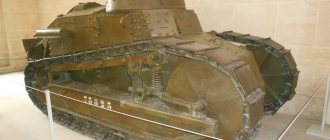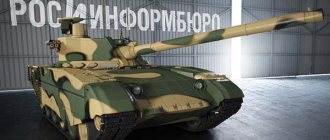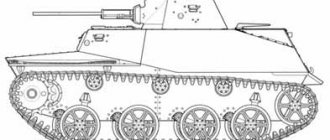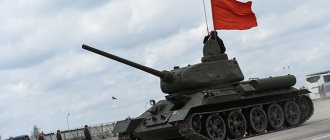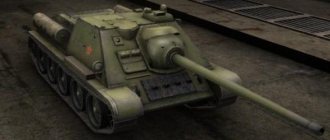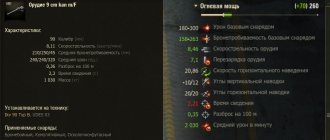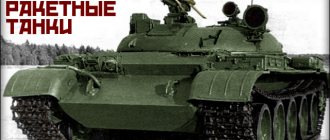French tanks of the First World War
The previous material examined German tanks of the First World War. Evolution and prospects of tanks
contributed to the creation of tanks in France.
French military requirements for a tank
Almost simultaneously with England, at the beginning of 1916, the development of assault tanks to overcome prepared enemy defenses began in France, culminating in the creation of the CA-1 Schneider and Saint-Chamon medium tanks.
Somewhat later, in May 1916, the Renault automobile manufacturing company, under the leadership of Louis Renault, proposed the concept of creating a tank of a fundamentally different light class - a tank for direct infantry support. The SA-1 and Saint-Chamon tanks, due to their purpose and capabilities, could not meet the requirements of the military. Cumbersome and unwieldy medium tanks, which were assigned the role of “ram”, were easy prey for enemy artillery, and they needed to be supplemented with numerous light combat vehicles to directly accompany the infantry and act in its battle formations, which would have a greater chance of success and survival on the field battle.
The military department was initially in no hurry to support this project, focusing on the development of assault tanks, but later supported the launch of the tank into mass production, and it became the most produced tank of the First World War. The tank was put into service in 1917 under the designation Renault FT-17.
The most popular tank of the First World War
This tank became the world's first mass-produced light tank and the first tank whose production was carried out using an assembly line method. The Renault FT-17 tank was also the first tank with a classical layout - it had a rotating turret, a control compartment in the front of the hull, a fighting compartment in the center of the tank and a motor and transmission compartment in the rear of the hull. The Renault FT-17 became one of the most successful tanks of the First World War and largely determined the further development of design ideas in tank building. The mass production of the Renault FT-17 tank was ensured by the simplicity of its design and low cost of production. The tank was developed at a company that mass-produced cars, and therefore many ideas and production methods from the automotive industry migrated to the design of the tank.
The adopted layout of the tank with two crew members eliminated a number of shortcomings regarding the habitability of the crew of medium and heavy tanks of that time. The driver was located in the bow of the hull, and he was provided with a good overview. The shooter with a weapon (cannon or machine gun) was in a rotating turret standing or half-sitting in a canvas loop, which was later replaced with a height-adjustable seat. The Renault FT-17 tank was inconspicuous compared to other tanks, its dimensions were 4.1 m long (without the “tail”), 5.1 m (with the “tail”), width 1.74 m, height 2.14 m.
Layout of the Renault FT-17 tank
The habitable compartment was separated from the engine compartment by a steel partition with two barred windows for air circulation. The windows were equipped with folding flaps to protect the crew in the event of an engine fire. This eliminated the entry of gasoline vapors and exhaust gases into the control compartment, reduced the danger for the crew in the event of a fire in the logistics compartment, ensured better weight distribution along the length of the tank and improved cross-country ability.
The crew boarded through a three-leaf bow hatch or through a spare hatch in the rear of the turret. The shooter rotated the turret using his shoulders and back with the help of shoulder pads, making rough aiming of the weapon. Using the shoulder rest of a cannon or machine gun, he aimed the weapon more accurately at the target. The weight of the tank in the machine gun version was 6.5 tons, in the cannon version 6.7 tons.
The hull of the tank was of a “classical” riveted design; armor plates and chassis parts were attached to the frame made of corners and shaped parts with rivets and bolts. The first samples of the tank had a cast frontal part of the hull and a cast turret with a spherical observation “dome”, which was made integral with the turret roof. Subsequently, the “dome” was replaced by a cylindrical cap with five viewing slits and a mushroom-shaped hinged lid. This simplified production and improved ventilation.
The difficulty of producing armor castings of the required profile forced us to switch to a completely riveted hull and turret from rolled sheets. The thickness of the armor of the front of the hull and turret in the cast version was 22 mm, in the riveted version 16 mm. The thickness of the armor in the riveted version of the hull is 16 mm, the front of the turret is 16 mm, the rear of the turret is 14 mm, the roof of the turret is 8 mm and the bottom is 6 mm.
The use of a rotating turret provided greater firepower in battle compared to turretless tanks. The tank was produced in two versions - “cannon” and “machine gun”, differing in the installation of the corresponding weapons in the turret. Most of the tanks were produced in the “machine gun” version. The “cannon” version featured a semi-automatic 37-mm Hotchkiss rifled cannon with a barrel length of 21 calibers; the “machine-gun” version featured a “long” 8-mm “Hotchkiss” heavy machine gun in the turret.
[center]Machine gun version of the Renault FT-17 tank
The weapon was placed in the frontal part of the turret, in a hemispherical armor mask on horizontal axles, mounted in a vertically rotating armor shield. The weapon was aimed by freely swinging with the help of a shoulder rest; the maximum vertical aiming angles ranged from −20 to +35 degrees.
Cannon version of the Renault FT-17 tank
The gun's ammunition load of 237 shells (200 fragmentation, 25 armor-piercing and 12 shrapnel shells) was located on the bottom and walls of the fighting compartment. The ammunition load for the machine gun was 4800 rounds. For firing, a telescopic sight protected by a steel casing was used. The gun provided a rate of fire of up to 10 rounds per minute and a firing range of up to 2400 m, however, due to the visibility conditions of the target from the tank, effective fire was up to 800 m. The armor-piercing projectile could penetrate 12 mm armor at a distance of up to 500 m.
The tank was powered by an engine from a Renault truck with a power of 39 hp, providing a maximum speed of only 7.8 km/h and a range of 35 km, which was clearly not enough for a light tank. Torque was transmitted through a bevel clutch to a manual gearbox, which had four forward speeds and one reverse. Onboard clutches served as the turning mechanisms. To control the tank, the driver used two steering levers, a gearbox control lever, gas, clutch and foot brake pedals.
The undercarriage on each side consisted of 9 support and 6 support rollers of small diameter, guide and drive wheels and a caterpillar track. The balance suspension was installed on leaf springs covered with armor plates. Six support rollers were combined in a cage, the rear end of which was attached to a hinge. The front end was suspended by a coil spring, which ensured constant track tension. The chassis provided the tank with a minimum turning radius of 1.4 m, equal to the vehicle's track width. The tank was clearly recognizable by the large diameter of the guide wheel, which was moved forward and upward in order to increase maneuverability when overcoming vertical obstacles, trenches and craters on the battlefield.
The tank's caterpillar was large-linked, lantern geared, 324 mm wide, and provided a low specific ground pressure of 0.48 kg/sq.m. cm and satisfactory cross-country ability on loose soil. To increase maneuverability through ditches and trenches, the tank had a removable “tail”, which was rotated onto the roof of the engine compartment, with the help of which the vehicle was able to overcome a ditch up to 1.8 m wide and a scarp up to 0.6 m high and did not tip over on inclines up to 35 °.
At the same time, the tank had low speed and a short range, which required the use of special vehicles to deliver tanks to the place of use.
Despite its shortcomings, the Renault FT-17 tank, due to its small size and weight, was much more effective than medium and heavy tanks, especially in rough and wooded terrain. It became the main vehicle of the French tank forces, the “symbol of victory” of France in the war and best demonstrated the promise of tanks. The Renault FT-17 tank became the most produced tank of the First World War, and about 3,500 of these tanks were produced in France. It was also produced under license in other countries; a total of 7,820 of these tanks of various modifications were produced, and it was in operation until 1940.
Tank "Freedom Fighter Comrade Lenin" based on the Renault FT-17 tank
In 1919, six Renault FT-17 tanks were captured by Red Army soldiers near Odessa. One tank was carefully copied and released with an AMO engine and Izhorsky armor, which became the first Soviet tank.
Assault tank SA-1 "Schneider"
In France, almost simultaneously with England, the development of tanks began. The concept of the tank also included the idea of creating an assault tank to break through prepared enemy defenses. The decision to develop the tank was made in January 1916, and on the initiative of the “father” of French tanks, Jean Etienne, its development was entrusted. In a short time, prototypes of the tank were manufactured and tested, and in September 1916, the first SA-1 assault tanks began to enter the army.
SA-1 tank in the museum
The French, like the British, created the SA-1 tank as a “land cruiser”. The tank's hull was an armored box with vertical walls. The front part of the hull was shaped like the bow of a ship, making it easier to overcome ditches and cut wire fences.
The tank's hull was assembled from armor plates secured with bolts and rivets to the frame, mounted on a rectangular rigid frame and elevated above the chassis. The rear hull was equipped with a small “tail”, which helped to increase the vehicle’s cross-country ability and ensure overcoming trenches up to 1.8 m wide. The tank was of impressive size, length 6.32 m, width 2.05 m and height 2.3 m and weighed 14. 6t.
The tank has a crew of 6 people - a commander-driver, a deputy commander (who is also a gunner), two machine gunners (the left one is also a mechanic), a gun loader and a carrier of machine gun belts. The crew boarded through a double door at the rear of the vehicle and three hatches on the roof, one in the roof of the commander's cabin and two behind the machine gun installations. The engine was installed in front on the left, and the commander-driver's seat was located to the right of it. For observation, a viewing window with a folding armored shutter and three viewing slits was used.
Tank SA-1
The thickness of the tank's hull armor was 11.4 mm, the bottom and roof were 5.4 mm. The armor turned out to be weak; the armor was penetrated by new German rifle bullets. After the first battles, it had to be reinforced with additional sheets with a thickness of 5.5 to 8 mm.
The tank's armament consisted of a 75 mm short-barreled Blockhaus-Schneider howitzer with a barrel length of 13 calibers, specially designed for this tank, and two 8 mm Hotchkiss machine guns with a rate of fire of 600 rounds per minute.
Since most of the bow of the tank was occupied by the engine and the commander-driver’s workplace, there was simply no space left for installing the gun; it, like a ship’s gun, was installed on the right side of the tank in the sponson in order to somehow ensure acceptable firing angles, but it still had a very small horizontal sector of fire of only 40 degrees. The commander-driver had to show extraordinary dexterity in order to keep the target in the gun's engagement zone when maneuvering.
The target range was 600 meters, the effective range was no more than 200 m. The initial projectile speed of 200 m/s was quite enough to combat light fortifications at a short distance, such as wooden dugouts. The gun was fired by the assistant commander, behind whom was located an ammunition supply of 90 shells.
The machine guns were installed on the sides in the middle part of the hull in gimbal mounts, covered with hemispherical shields. The machine gunner fired from the right machine gun, and the mechanic fired from the left, who also monitored the operation of the engine. The machine guns also had large dead zones that did not provide effective fire.
SA-1 tank on the march
A Schneider or Renault engine with a power of 65 hp was used as a power plant; a fuel tank with a capacity of 160 liters was first located under the engine, then it was moved to the rear of the tank. The transmission included a 3-speed gearbox with reverse, which allowed you to change the speed in the range of 2-8 km/h, and a differential turning mechanism. The power plant provided a maximum highway speed of up to 8 km/h, but the actual speed was 4 km/h on the highway and 2 km/h over rough terrain. The tank's cruising range on the highway was 45 km, and on rough terrain 30 km.
One of the advantages of the tank was its high smoothness; thanks to good shock absorption in the suspension system, this reduced crew fatigue and increased shooting accuracy. The chassis of the tank was borrowed from the Holt tractor, which underwent serious processing.
Tank SA-1. Side view
On each side, the chassis consisted of a pair of bogies with road wheels (three on the front, four on the rear), a guide wheel at the front and a drive wheel at the rear. The advantage of the chassis design was the semi-rigid suspension. The 360 mm wide track contained 34 large tracks, consisting of a cushion and two rails, along which support rollers with flanges rolled. With a track support surface length of 1.8 m, a specific ground pressure of 0.72 kg/sq.m was provided. cm.
Tank SA-1. Back view
The effectiveness of the CA-1 tanks was not as high as planned. An unsuccessful layout with a chassis that was too short for such a massive hull, clumsiness, insufficient maneuverability and poor protection made the tank vulnerable to enemy fire.
Overcoming a trench with the SA-1 tank
The first mass use of SA-1 tanks took place in April 1917. The French command planned to throw a large number of tanks into battle at once and, with their help, break through the German defenses. However, the Germans were able to accurately determine the location of the impending offensive and prepared anti-tank defenses in the direction of attack, bringing up additional artillery.
The ensuing offensive resulted in a real massacre for the French. The tanks came under massive artillery fire. In total, the French were able to throw 132 SA-1 tanks into battle, while the tanks only managed to break through the first line of German defense, losing 76 vehicles and their crews, who were shot at by German planes. So the first debut of the SA-1 tanks was not entirely successful.
The total number of SA-1 tanks produced is estimated at about four hundred and it did not become a massive tank of the First World War.
Assault tank "Saint-Chamond"
The development of a second Saint-Chamon assault tank in addition to the already developed SA-1 was not needed by the French army, but the ambitions of the military commanders played a role here.
The development of the SA-1 tank was ordered by the “father” of French tanks, Jean Etienne, who implemented his project on his personal initiative without the approval of the artillery department. The management decided to implement a project to develop the same machine at the FAMH company, located in the city of Saint-Chamon. This is how two assault tanks appeared, not fundamentally different from each other. In February 1916, a task was issued to design a tank, and in April the project was prepared. Testing of the first samples began in mid-1916, and the first deliveries to the army in April 1917, initially as armored supply vehicles without weapons
Tank "Saint-Chamond"
Externally, the Saint-Chamon differed from the SA-1 in its larger size and the presence of a long-barreled gun in the nose of the tank. The hull was an armored box with vertical sides and sloping cheekbones at the bow and stern, which extended far beyond the dimensions of the tracks. The hull was assembled from sheets of rolled armor riveted onto a frame and mounted on a frame to which the chassis was attached. Initially, armor plates on the sides covered the chassis and reached the ground, but after the first tests this was abandoned, since such protection worsened the already low cross-country ability.
Design of the Saint-Chamon tank
On the first samples, the front hull had commander and driver cylindrical turrets, then instead of cylindrical turrets, box-shaped turrets were installed. The gun along the axis of the tank was located in the large front bulge of the hull, which was balanced by the aft niche, and the engine and transmission were located in the middle part of the hull.
The tank had a crew of 8-9 people (commander, driver, gunner, mechanic and four machine gunners). In front on the left was the driver, and on the right was the commander, using observation slits and turrets for observation. The gunner was located to the left of the gun, and the machine gunner to the right. In the stern and along the sides there were four more machine gunners, one of whom was also a mechanic. Doors on the sides of the front of the tank were used for boarding the crew. Viewing slits and windows were equipped with shutters.
Control department of the tank "Saint-Chamon"
The length of the hull without a gun was 7.91 m, with a gun 8.83 m, width 2.67 m, height 2.36 m. The weight of the tank was 23 tons. The thickness of the armor plates on the front of the hull was 15 mm, the side was 8.5 mm, feed – 8 mm, bottom and roof – 5 mm each. Subsequently, the thickness of the frontal armor was increased to 17 mm, to prevent penetration by new German armor-piercing bullets.
The cannon armament used was a 75 mm long-barreled field gun with a barrel length of 36.3 calibers and an eccentric bolt. The dimensions of such an installation and the relatively long recoil of the gun when fired determined the large length of the bow of the hull.
The aimed firing range of the gun was up to 1500 m, but achieving such characteristics was impossible due to unsatisfactory conditions for firing from the tank, since horizontal guidance was limited to 8 degrees. So the transfer of fire was accompanied by a rotation of the entire tank, moreover, the vertical pointing angle of the gun was only from -4 to +10 degrees. To combat infantry, there were frontal, rear and two side mounts of 8-mm Hotchkiss machine guns. Ammunition for the cannon was 106 rounds, and 7,488 rounds for the machine guns.
The tank's power plant was a 90 hp gasoline engine with a fuel supply of 250 liters. The original feature of the tank was the electric transmission. The engine worked on an electric generator, the voltage from which was supplied to two traction electric motors, each of them, through a mechanical reduction gear, drove the track of one side. The power plant provided the tank with an average speed of 3 km/h, a maximum speed of 8 km/h and a cruising range of 60 km.
Tank "Saint-Chamon" during testing
The driver simultaneously controlled the carburetor throttle with one pedal, adjusting the engine speed, and changed the resistance of the primary winding, adjusting the current in the primary winding of the generator. When turning, the rotation speed of the electric motors changed, and when they were switched to reverse, the tank was provided with reverse gear. The electric transmission provided a smooth change in speed and a turning radius over a wide range, reduced the load on the tank engine and required little effort from the driver when controlling the movement. But the electric transmission was bulky and heavy, which increased the weight of the tank.
The chassis was also based on the components of the Holt tractor, which were significantly modified. The chassis included three bogies with dual road wheels on one side. The body frame rested on bogies through vertical helical coil springs. The track was 324 mm wide and consisted of 36 tracks, including a shoe and two rails. The length of the supporting surface was 2.65 m. With such a caterpillar, there was a high specific pressure on the grant and the width of the caterpillar was increased to 500 mm, while the specific pressure decreased to 0.79 kg/sq. cm.
Due to the overhang of the front part of the hull over the tracks, the vehicle had difficulty overcoming vertical obstacles and ditches 1.8 m wide. The tank's maneuverability on the ground was noticeably worse than that of the SA-1 tank. The heavy nose led to frequent deformation of the front bogies and the tracks falling off.
In general, the Saint-Chamon tank was much inferior to the same SA-1, which itself did not shine with reliability and maneuverability, so the army ended up with a second assault tank with very mediocre characteristics.
Saint-Chamond tanks in battle
In the first battle in May 1917, the Saint-Chamon tanks were unable to overcome the trenches, stopped in front of them and were hit by enemy artillery or failed due to breakdowns. Other battles were just as unsuccessful for these tanks.
In the last months of the war, "Saint-Chamon" was often used as self-propelled guns; thanks to its long-barreled 75-mm cannon, they successfully fought with German close-range batteries. This tank also did not become widespread during the war; a total of 377 tanks of various modifications were manufactured.
Development of tank building
Until the end of the First World War, heavy tanks 1A and 1B were developed, but things did not go further than the development of prototypes.
After the war, France had the largest number of battle tanks. On this basis, General Etienne tried to organize independent tank forces divided into light, heavy, and medium tanks. The generals thought differently, and from 1920 all tank units were subordinated to the infantry. A division into infantry and cavalry appeared.
But Etienne’s activity was not in vain; until 1923, 10 heavy multi-turreted 2C tanks were produced, and a whole series of light tanks of the 1921, 1924, 1926 and 1928 model, under the designation M21, M24, M26 and M28, was produced. On models of this series, the French were the first in the world to use the possibility of dual cross-country ability: tracked engine + wheels. The type of propulsion varied depending on the circumstances. The most original solution was used on the M24 and M26.
Regretting the write-off of the Renault FT, created with such difficulty, they were constantly modernized. After another modification in 1927, the tank was already called NS1, and NS3 became the prototype of D1, in 1936 D1 “grew” into the medium D2.
France was not spared the craze for wedges in the 1930s. From 1931 to 1940, the French produced 6,200 light tracked vehicles UE, externally reminiscent of the English Vickers-Carden-Loyd Mk VI wedges. The troops called them “infantry tractors.”
After France adopted the army's motorization program in 1931, special attention was paid only to the development of wheeled and reconnaissance vehicles. The AMR light tank is represented under this program. Without much support from senior officials. Renault and FSM are starting a joint production of the B1 heavy tank, which is not an ordinary tank in all respects.
Due to a lack of understanding of the capabilities of tanks and their assigned infantry support roles, France built only 170 new tanks in the 17 post-war years. The country did not have tank troops in 1936; at that time, the army had, in addition to the obsolete FTs, 17 B1, 17 D2 and 160 D1. After the well-known events in Spain and Ethiopia, the command, realizing the approaching threat and the complete incompatibility of its own army with the new maneuver war, adopted a 4-year army construction plan. During the period 1936-1940, 3 light mechanized, 2 tank divisions and 50 separate tank battalions equipped with new tank developments should have been organized.
Mass serial production of the newly created and Renault light tanks H35 and R35 begins. (the number in the name of French tanks often indicates the year of creation). H35 was considered cavalry. introduced an interesting model FCM36, but before the start of the war, due to the high cost, only 100 units were produced.
In 1936, the SOMUA S-35 became the main medium tank, which was originally created for operations as part of cavalry units. Due to the absence of other similar tanks, it is credited with the role of a tank capable of independently solving tactical problems.
At the time of the German invasion, France had 2,700 light tanks in service, a little more than 300 medium, 172 heavy, old 1,600 Renault FTs and 6 2Cs. Although the number of combat vehicles increased, the lack of understanding of the doctrine of using tanks on the battlefield and poor training and manning of the crews did not bring any serious results; all the tanks were destroyed or passed into the hands of the Germans.
